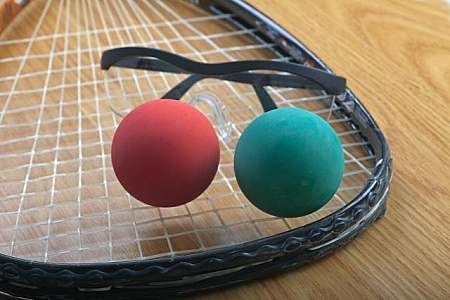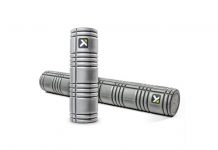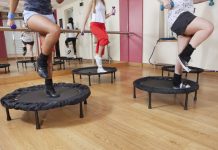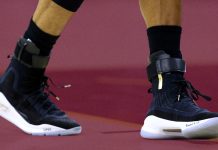
The Fitness Report is all about competitive games that keep you fit no matter your age or skill level. Racquetball is a fast-paced, exciting game that requires not only speed and strength, but also finesse and strategy. Playing on an elite level takes years of practice, but whether you aim to become the best in the world or you’re just interested in it as a new way to have fun and stay fit, choosing the right racquetball racquet is key. A good racquet will enhance the power of your swing and help you control where the ball goes while a bad one may hinder even the best players.
Selecting a good racquetball racquet isn’t easy, so we set out to simplify the process for you. We did the research to determine what makes a good racquetball racquet and then we compared the top models on the market to see which ones performed the best. Our favorite was the Wilson Drone X Racquetball Racquet. Its light weight, excellent balance and sheer power make it popular among racquetball players of all experience levels, and Wilson is also the official racquetball racquet for Team USA. But depending on your playing style and experience level, you may prefer one of our other top picks.
Keep reading to learn more about our racquetball recommendations and how to choose the one that’s right for your game.
Quick Summary: Fitness Report Picks for the Best Racquetball Racquets
- Best Overall: Wilson Drone X Racquetball Racquet
- Best for Novices: HEAD i.165 Racquetball Racquet
- Best for Experienced Players: Ektelon Toron 150 ESP Racquetball Racquet
- Best for Slower Swingers: E-Force Apocalypse Series Racquetball Racquet
The Best Overall Racquetball Racquet: Wilson Drone X Racquetball Racquet
The Wilson Drone X Racquetball Racquet has gained a large following because it does such an excellent job of balancing maneuverability and power. Weighing in at just 169 grams, it’s easy to swing through the air without battling drag and it’s evenly balanced so you don’t have to sacrifice control for power. Those who have tried it out have been impressed by how much power the racquet does generate and by the durability of the racquet. There have been few reports of cracked frames and most users report that it holds up well over time.
Another thing that surprised users about the Wilson Drone X racquet was how little vibration it generated, even on big shots. The racquet does not come with a vibration dampener, but many have said that they don’t feel that one is necessary, given how easily the racquet absorbs the blow.
The racquet is available in red and pink models, and both of them have 3 ⅝-inch grips. The majority of players who try this racquet are happy with this size, but if you have especially large hands, you may prefer a racquetball racquet with a larger grip instead.
The Wilson Drone X racquet is surprisingly affordable compared to many other racquetball racquets of a similar caliber, but that doesn’t mean it’s cheap. Beginners may want to invest in something that’s a little more affordable, but for the regular racquetball player, the Wilson Drone X is an excellent value. It doesn’t come with a case, however, so you will have to purchase one of these separately.
What You Need to Know Before Buying a Racquetball Racquet
There are many factors you need to consider when selecting a racquetball racquet. Here’s a look at some of the most crucial:
Racquet Weight
Your racquet’s weight is important because it dictates how easy it is to swing the racquet and how much power and control you have over your shots. Racquetball racquets break down into three main categories based on their weights. Lightweight racquets are usually considered those that are 165 grams or less. These racquets are favored by experienced players who have a fast swing and are capable of generating a lot of their own power.
Medium-weight racquets are those between 165 and 175 grams. Racquets in this range are the most popular because they do the best job of balancing control and power, enabling you to swing your racquet quickly without having to put so much of your own force behind the swing in order to hit a powerful shot.
Heavyweight racquets are those weighing more than 175 grams. These racquets are a good fit for those who have a slower swing and cannot generate as much power on their own. Beginners often start with a slightly heavier racquet and some older players who can no longer hit with the power that they used to may transition back to a heavier racquet as they age.
Balance
Racquetball racquets may be either head-heavy, head-light or evenly balanced. Head-heavy racquets, as the name implies, have most of their weight in the racquet head. This puts more weight and speed behind your swing, helping you to hit more powerful shots. Head-light racquets have most of their weight toward the handle, or throat, of the racquet. This maximizes maneuverability, but there’s a bit of a tradeoff with power. However, these racquets are still a great fit for frontcourt play. For most players, though, an evenly balanced racquet is the way to go. It’s the most versatile option and suits individuals with all different styles of play.
Grip Size
The majority of racquetball racquet grips are around 3 ⅝ inches in diameter. This size should accommodate most people’s hands comfortably without being so large that it inhibits your ability to snap your wrists. But there are smaller and larger grips available for those who are interested. You don’t want to choose a grip that’s too small for your hand size, though, because this could lead to wrist or elbow pain from over-clenching the racquet handle.
Racquet Stringing
The initial stringing on your racquetball racquet shouldn’t be a make-or-break feature because you can always have it restrung if you don’t like it. But if you want to be able to play with your racquet right out of the box, you’ll want to pay attention to how it is strung. Like the weight and balance of the racquet, racquet stringing comes down to a tradeoff between control and power. A looser-stringed racquet has more spring so it’s capable of generating more power. On the other hand, a tighter-stringed racquet has less spring, so it generates less power but gives you greater control over where you want to place the ball.
Racquetball Racquet Reviews: A Look at Our Other 3 Top Picks
The Wilson Drone X is a versatile racquetball racquet that’s well-suited to intermediate to advanced players, but it’s not the only racquet that’s worth considering. Here are three more that we recommend taking a look at before you make your final decision.
Best for Novices: HEAD i.165 Racquetball Racquet Review
The HEAD i.165 Racquetball Racquet is considered one of the best options for novices interested in giving racquetball a try. A key reason for that is its low price tag. It’s much more affordable than any of the other racquetball racquets listed here, so it’s more appealing for those who aren’t sure if they’ll want to stick with the sport. That said, the low price tag doesn’t mean you’re getting a poor-quality racquet. It’s made of a durable titanium frame and users report that it lasts for years, even after they’ve accidentally hit the wall with it.
The racquet is lightweight and generates a fair amount of power and speed. The strings are tightly-strung and players have said that the racquet vibrates very little, especially when you use the included vibration dampener. The tighter racquet swings give you more control over your shots, which is especially helpful to novices, but more advanced players may find this too restricting.
The HEAD i.165 racquet has a standard 3 ⅝-inch grip, which some players have complained slips out of their hands while they are playing, but this is easily remedied by adding a tackier grip on your own. The racquet also includes a wrist strap to help keep your racquet from flying across the room.
Best for Experienced Players: Ektelon Toron 150 ESP Racquetball Racquet Review
The Ektelon Toron 150 ESP Racquetball Racquet is a popular choice for more advanced players in part because of its featherlight weight. At a mere 150 grams, it’s one of the lightest racquetball racquets on the market and it’s one of the best in terms of maneuverability. The secret to its lightweight design is a composite graphite frame that lends a lot of strength to the racquet without adding much weight. Users have said that the racquet lasts for several years of regular use without cracking.
It’s a racquet that’s better suited to finesse players than those who rely mostly upon raw power. The string tension is lower than on many comparable racquets, but this is easy to adjust if you prefer strings with a little more tension. A few users have reported issues with tennis elbow that were remedied by increasing the string tension. The racquet is available in three different grip sizes, so you shouldn’t have any trouble finding one that suits you.
The one thing that may give you pause is the price tag on this racquet. It’s on the high end for racquetball racquets, so if budget is an issue for you, the Wilson Drone X will be a better fit. You may also want to go with something cheaper if you’re new to the sport. But if you’re an experienced player and you know you’ll use your racquet often, the Ektelon Toron 150 ESP racquet is well worth the investment.
Best for Slower Swings: E-Force Apocalypse Series Racquetball Racquet Review
The E-Force Apocalypse Series racquetball racquets are another excellent choice for experienced players. The key difference between these racquets and the Ektelon Toron 150 ESP racquet is the weight. The Apocalypse Series has racquets of several different weights, ranging from 160 grams on the low end to 190 grams on the high end. There are also 170-gram and 175-gram racquets for those who want something in the middle. Few other racquetball companies make racquets as heavy as 190 grams, and this extra weight, while not suitable for all players, is a great fit for those with slower swings who need a little more help generating power.
For those who prefer a lighter racquet, the 160-gram model can compete with the best lightweight racquets, offering excellent maneuverability and control on every shot. It employs a unique bypass stringing system which helps to soften the vibration when the ball hits the racquet while increasing your ability to direct your shots. The only major complaint that users seemed to have with this racquet was a smaller sweet spot compared to many other racquets. This could pose an issue for beginners, but experienced players shouldn’t struggle with it too much.
The E-Force Apocalypse Series racquets are slightly more affordable than the Ektelon Toron 150 ESP racquet, so one of these is a great alternative for experienced players who have a budget to think about. It’s still more expensive than a novice racquet like the HEAD i.165 racquet, but this is expected, given the superior design of the E-Force Apocalypse Series racquets.
Step Up Your Game with the Right Racquetball Racquet
While experience and skill are undoubtedly the most important factors in a racquetball game, the racquet you’re using is arguably the second-most important consideration. Novices will want to pick a racquet that they can grow into as they progress, while experts will want to pick a racquet that exploits their particular skills. The right racquet can elevate your game to new levels while the wrong one may weigh you down and cause your shots to go awry. Finding the right racquet isn’t always easy, and it could change over time as you grow in skill, but you can simplify your search by understanding the factors that influence the power and control that each racquet provides.
The Wilson Drone X Racquetball Racquet is a versatile choice that will suit players of all levels and styles of play, so we recommend trying this one first. But beginners may prefer to start with a more affordable racquet like the Head i.165 Racquet while more experienced players who know exactly what they’re looking for in a racquet may favor the Ektelon Toron 150 ESP Racquet or the E-Force Apocalypse Series racquets. Remember, there is no wrong answer. It all comes down to how you play.

























